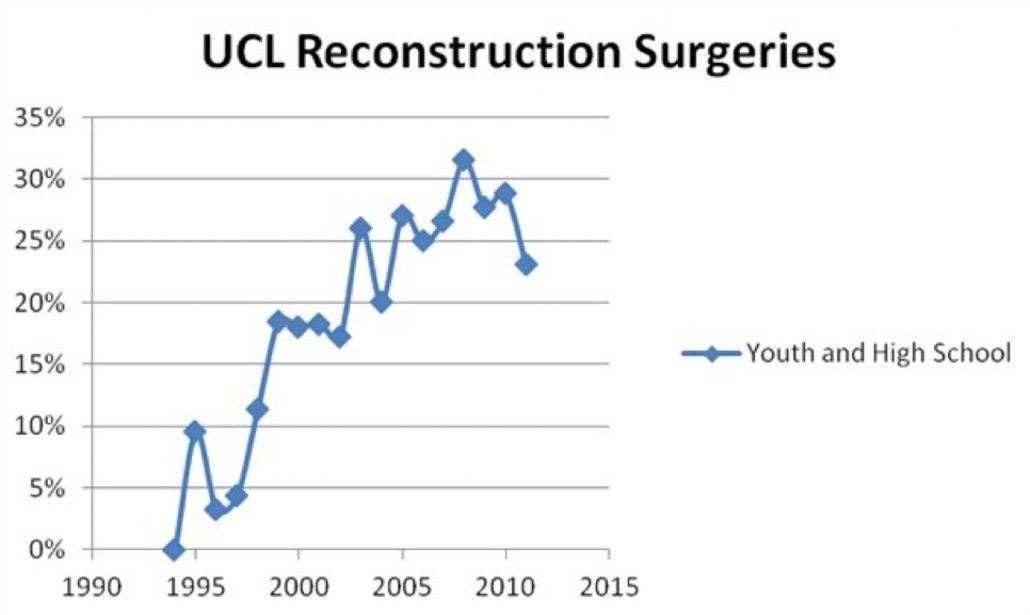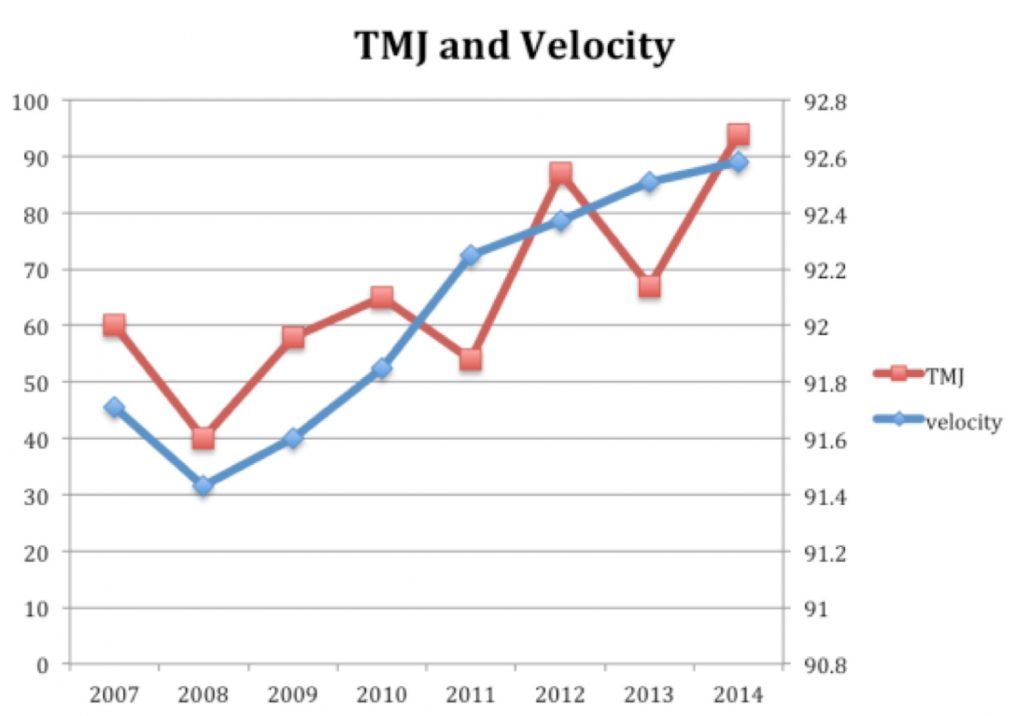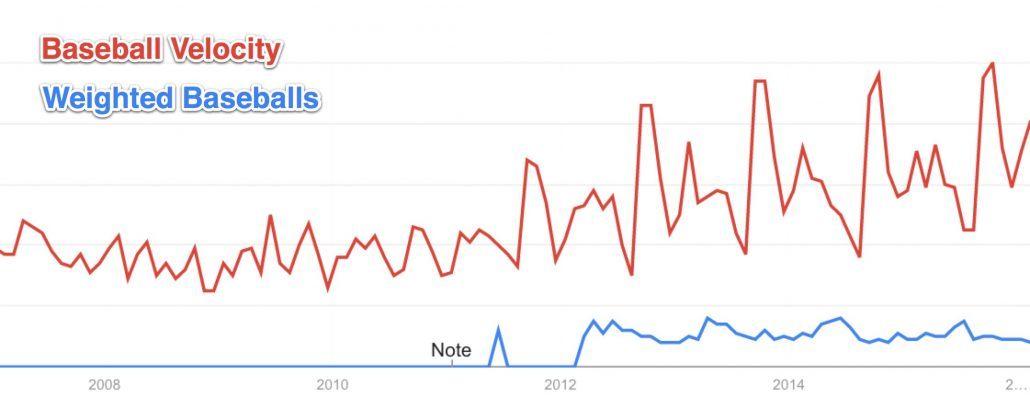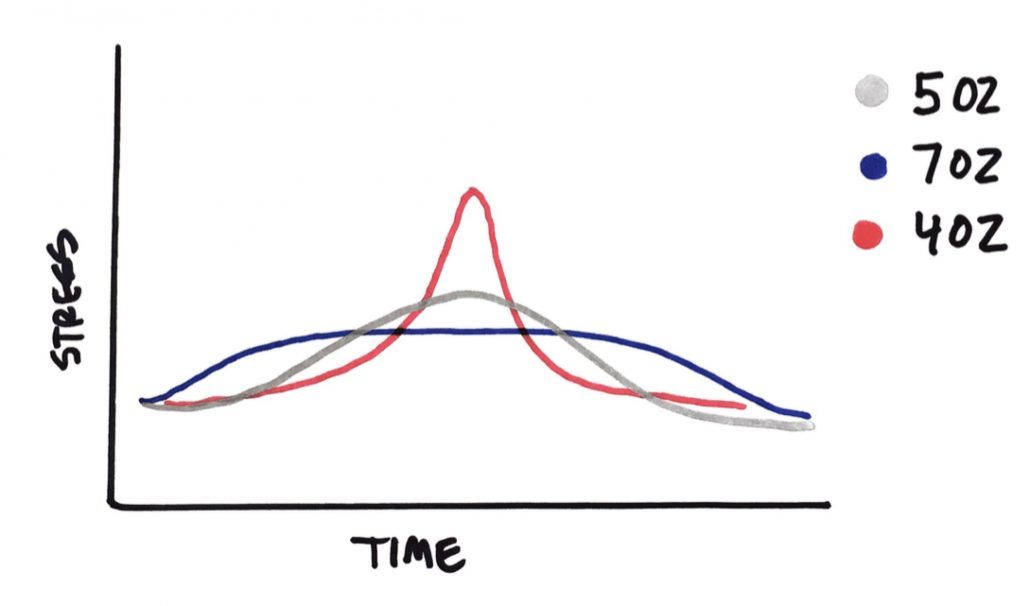One thing is certain when it comes to baseball pitching injuries, they are rising. Another thing is also certain, baseball velocity programs are ridiculously popular to enhance pitching velocity.
This winter I was honored to be a speaker at both the Professional Baseball Athletic Trainers Society Medical Meeting and the American Sports Medicine Institute Injuries in Baseball Conference. In both meetings we spent countless hours discussing the rise in injuries and what we can do to help reduce these alarming rates.
I believe the biggest thing we can do is educate, and that is the intent of this article.
Recent reviews of Major League Baseball data have shown that 25% of all pitchers in MLB have had Tommy John surgery. I’ve written in the past about why Tommy John injuries are rising in Major League Baseball. While this is amazing to begin with, a scarier trend is also emerging. 86% of MLB pitchers had their Tommy John surgery while playing professional baseball. However, 61% of all minor league baseball players had their Tommy John surgery during high school or college.
Pitching injuries are occurring at an earlier age.
A recent study in The Physician and Sports Medicine showed that 30% of youth baseball players up to the age of 12 reported episodes of shoulder or elbow pain. Another report in the Journal of Arthroscopy noted 31% of pitchers up to the age of 22 have experience an arm injury.
Dr. Ahmad of the New York Yankees reported in the American Journal of Sports Medicine on the rise in Tommy John surgery over a 10-year period in the state of New York. The volume of surgeries increased 193% between 2002 and 2011. Plus, there was a statistically significant trend towards the age of surgery going down, meaning that more and more kids are having Tommy John surgery at an earlier age.
Dr. James Andrews, who has done more Tommy John surgeries than anyone else, has been discussing how he is seeing a rise in Tommy John surgery in youth baseball pitchers. At meetings, he tells the story of how he used to see just a few kids a year, but now over a third of Tommy John procedures he performs are in youth pitchers. Here is a graph showing the rise in Tommy John surgeries performed each year by Dr. Andrews:
Why Do Baseball Pitching Injuries Occur?
Over the years, we have hypothesized many potential causes of the rise in injuries in baseball but the research keeps coming back to two primary causes of pitching injuries:
- Overuse
- Increased velocity
Pitchers that throw more innings, more pitches per game, more games per week, play for multiple teams, and participated in more showcases have all been shown to have higher injury rates. But it’s not just overuse during the season, it’s overuse throughout the year. In a landmark study by ASMI, pitching for more than 8 months out of the year resulted in a 5x greater chance of sustaining an injury. This is significant.
Combining all the great research now available to us, here is how the chance of youth baseball injuries increase due to overuse:
- Pitching > 100 innings in one year = 3x greater risk of injury
- Averaging > 80 pitches per game = 4x greater risk of injury
- Pitching > 8 months per year = 5x greater risk of injury
- Regularly pitching with arm fatigue = 36x greater risk of injury
Our trend towards emphasizing velocity more than any other pitching attribute is not helping either. Two studies, one in the American Journal of Sports Medicine and the other in Sports Health, have shown a correlation between velocity and elbow stress in high school and professional baseball pitchers.
While increased stress on the Tommy John ligament does not necessarily mean they will get injured, ASMI has also noted that velocity correlated to injuries and that pitchers that threw harder had a 2.6x greater chance of getting injured. In the previously mentioned article in Arthroscopy, an increase in velocity was associated with a 12% greater injury risk.
So it makes sense that we are seeing a rise in both the average pitch velocity in Major League Baseball and the number of players undergoing Tommy John surgery:
Essentially, the harder and more often you throw, the higher your chance of injury.
Many people are perfectly OK with accepting this risk, and I am too. But, the fact that throwing a baseball is not good for your body is very apparent and the first thing that we must all understand when designing baseball training programs.
The Evolution of Baseball Training and Velocity Programs
I believe we are in what I would call the “velocity program” era of baseball training. The primary focus of every kid in America is on performing a “velocity program” that they saw on the internet and essentially guarantees a huge increase in velocity.
The internet is filled with a lot of information. This is a great thing and allows us all to learn at a rapid pace. However, it’s difficult to determine who we should actually be listening to and trusting. Often times the most articulate writers with the most impressive videos will get the most exposure. What we are seeing is a blind trust and faith in these recommendations based on anecdotal information and limited science.
This is a huge problem to me. The science is not adding up.
The two biggest offenders I see right now are weighted ball and long toss programs. These programs have become popular.
Below are the Google search term trends for “weighted baseballs” and “increase baseball velocity” from 2004 to February 2016. You can see a trend upward as well as the rise in popularity of weighted baseballs over the last few years:
Let me be clear and get this out of the way. I am a believer of performing weighted baseball and long toss programs. I incorporate them into my programs and think you should too. (No one will remember those last two sentences, by the way).
It’s not the program that is the problem, it’s how these programs are being implemented.
It all comes down to “dosage.” We all know that medicine is effective. But there are side effects to all drugs and, more importantly, you can overdose and cause more harm than good.
I believe we are overdosing on velocity programs.
We are putting a lot of faith into programs being marketed on the internet that have not been validated scientifically to be safe or effective. Again, just to be clear, there are many smart coaches on the internet with great programs. I follow many great minds and really respect what they do. But realize that:
- People are trying to implement these programs on their own without thought or a clear understanding on what is safe and effective. They are not selecting the appropriate dose.
- People are implementing the same velocity program for everyone, often on a team-wide basis, not individualizing the dose for each individual.
- People are getting greedy. Many people think if a 1 lb ball can help them gain 3 MPH, than a 2 lb ball can help them gain 6 MPH! They are overdosing.
We have a very limited understanding of the science weighted baseball, long toss, and other baseball training and velocity programs, but research is starting to come out. Below is what we currently know regarding weighted ball and long toss programs.
If you are going to start a pitching velocity training program yourself of with athletes, you MUST understand the science.
The Science of Weighted Ball Velocity Programs
Weighted ball training programs work. We have enough evidence to know that weighted ball training helps to increase pitching velocity. We’ve known this for decades. But at what cost?
I can tell you from my experience as the person on the other side of the equation, I hear this comment all the time from injured baseball players: “I started a weighted ball training program this winter, gained 3-5 MPH on my fastball, and then hurt my arm for the first time during the season.” I can’t tell you how common that is at Champion every day. This is all I do every day.
How about this conversation I recently had:
- Pitcher: “I hurt my shoulder two weeks ago and can’t throw without pain.”
- Me: “Have you ever hurt your arm before?”
- Pitcher: “Never.”
- Me: “Did you do anything different this offseason?”
- Pitcher: “I started an aggressive long toss program to 300+ feet and weighted ball program.”
- Me: “How did it go?”
- Pitcher: “This is the best my arm has ever felt.”
- Me: “Wait, you just said you can’t throw because of pain for the first time, sounds like this is the worst your arm has ever felt.”
- Pitcher: [blank stare…]
As you can see, his perception may be the biggest part of the problem.
**Update – since the writing of this article, I have been working with this same athlete. We toned down his program completely, building up his body and strengthened his arm. After that, and only after that, did we start a much milder version of a velocity program with long toss and low dose/frequency weighted balls. His velocity is up even MORE this year and his arm feels great, but I really wanted to share the message I got from him: “Hit 92 MPH the other day, I guess less is more!”
We still don’t know how safe these programs are and, more importantly, what the effective “dose” should be to increase pitching velocity. What I mean by this is, how heavy, how light, how many throws, how often per week, and how much during the year among other questions. Selecting the right dose is important, and it should start with the minimum viable dose to achieve a training effect.
We still do not know the safest and most effective “dose” for pitching velocity programs, just like medicine, more is not better. [Click to Tweet]
The first study to look at the biomechanics of weighted ball programs has been submitted for publication by Dr. Glenn Fleisig and ASMI. Dr. Fleisig presented the results of their study at the ASMI Injuries in Baseball Course. Their study looked at mound vs. flat ground throwing of 4, 5, 6, and 7 oz balls. Although limited in what was evaluated, they showed that throwing balls less than a 5 oz regulation ball increased the amount of stress on the arm.
What tends to happen with overload balls is less stress but over a longer period of time, and for underload balls it’s more stress over a shorter period of time, which is a bad combo. Sorry for my crude drawing but here is a graphic visualization of this concept:
The 7 oz throws were less stressful than a regulation ball, however, we still don’t know if this changes as the balls get heavier or if they change with more intense run-and-gun or turn-and-burn style throws. These were not studied. I think they do.
We have recently finished up a big study at Champion PT and Performance where we have teamed up with ASMI, Dr. James Andrews, Dr. Glenn Fleisig, and Motus Global to research weighted ball programs. In the first phase of the study we are using knee throws, rocker throws, and run-and-gun throws using between 2oz and 2lb balls.
I’ve recently published the whole summary on this study, which you should definitely ready:
- [Releated Post] Are Weighted Baseball Velocity Programs Safe and Effective?
We found that weighted baseball programs can be effective at enhancing velocity, but at what cost? We have a 24% injury rate, which we feel was due to significant increase in shoulder external rotation range of motion. That’s not good. Furthermore, performing a weighted baseball training program did not increase arm strength, arm speed, or mechanical changes.
Unfortunately, this is was my hypothesis. Weighted ball programs using weights more than 5oz are effective at enhancing velocity. I believe this may be because it causes such a quick and dramatic increase in external rotation, or layback. Increasing this layback correlates to greater velocity.
Weighted baseball training programs may be changing out anatomy.
Scientifically, this gain in external rotation is not from a muscle stretching or the bone adapting. It wouldn’t happen that fast. What is likely happening is that the static stabilizers that are supposed to prevent excessive external rotation are being damaged. This could be the capsule, labrum, or even rotator cuff. These are not injuries that you want. Plus, as layback increases, so does stress on the Tommy John ligament.
This is why many people do not get hurt during a weighted ball program, but end up getting hurt down the road. They’ve pushed past their normal anatomy to increase pitching velocity.
So weighted ball programs have two potential concerns:
- Overweight balls may be causing damage to the tissue of the shoulder to allow more layback. This gain in layback may also increase the strain on the Tommy John ligament (among other things).
- Underweight balls increase the amount of peak strain on the arm.
The Science of Long Toss Velocity Programs
In addition to weighted ball programs, we have also seen an increase in baseball long toss programs designed to improve pitching velocity. Long toss is nothing new, but throwing maximum distance and trying to extend this distance over time has become more popular.
Similar to weighted ball programs, we are starting to see studies published quantifying the stress observed on the throwing arm during long toss throwing. You have to take the science of long toss into consideration.
Dr. Fleisig and ASMI evaluated the stress observed during long toss programs in past studies. One of these studies, published in the American Journal of Sports Medicine, studied the difference between pitching off a mound and long tossing at 120 feet, 180 feet, and at maximum distance. Long tossing to 120 feet had similar stress on the arm as pitching on the mound. Throwing to 180 feet had greater stress.
However the most alarming finding of the study involved throwing maximum distance. When subjects were asked to use a crow hop and throw as far as they could, the stress on their arm increased by 10% more than pitching off the mound (and their mechanics changed too…)! It should be noted that the mean distance thrown was 264 feet, less than what many people throw.
Another recent study publish in the American Journal of Sports Medicine by Dr Elattrache of the Los Angeles Dodgers showed no significant difference between pitching off the mound and long toss throwing between 60 and 180 feet. Let’s be really clear on this one, the amount of stress on the shoulder and elbow were the same as pitching off the mound AND throwing flat ground from even as short as 60 feet, despite a significantly lower velocity during the throw. Perhaps throwing flat ground is less biomechanically efficient.
It is apparent that the longer you throw, the more stressful it is on the arm, even more so that pitching off the mound.
Long toss is important. But again perhaps we are using the wrong dose.
I for one have worked with many players that love long toss and many players that hate long toss. I’ve worked with MLB All-Stars and Cy Young winners on both sides. I have worked with some that can easily throw 250+ feet without any sign of altered mechanics, while others labor at 180 feet.
Perhaps our issue is more related to the fact that one magical long toss program doesn’t exist.
Trying to say that a certain distance is recommend for everyone is very disadvantageous. Everyone is different. Think about it this way, should a 5’8″ tall pitcher and 6’6″ tall pitcher throw the same distance? Should a sidearm pitcher throw the same distance as someone more over the top? Should a 15 year old skeletally immature kid throw as far as a 30 year old big leaguer?
Long toss programs need to individualized for each person. Similar to weighted ball programs, we now know that the stress on the arm exceeds pitching off the mound.
Do We Want to Expose the Throwing Arm to Increased Stress?
I think we do. The body is a really amazing thing. It’s really good at adapting to applied demands. We’ve shown scientifically that:
- If you throw too MUCH when your growth plates are open, you place too much stress on the arm and greatly increase your chance of injury
- If you throw too LITTLE when your growth platers are open, you don’t apply enough stress to develop the physical ability to throw hard when you are older
Exposing the body to increased stress is a good thing. This is how it adapts. But just like a rubber band, if apply put too much stress or too many repetitive stresses, it will snap.
We need to expose the throwing arm to increased stress. I don’t think the real problem is that these weighted ball and long toss velocity programs apply more stress on the arm. That may be advantageous to an extent to build load tolerance by exposing the body to this extra stress. It again just comes back to dosage.
These imposed demands need to be applied scientifically with the appropriate intensity, volume, frequency, and timing during the year. This is not happening.
Are Velocity Programs to Blame for the Rise in Baseball Pitching Injuries?
I don’t think velocity programs directly to blame for the rise in baseball pitching injuries. It’s not the program, it’s the dose.
So what we know right now is that both weighted ball and long toss programs produce more stress on the arm than pitching off a mound. Again, this is acceptable if applied appropriately, and in fact this may be desired.
But let me ask you a couple of big questions:
- Would you throw a bullpen 6x per week?
- Would you throw bullpens all year around?
I hope you said “no” to both of those questions. If not, you have a lot of reading to do. Remember, pitching for more than 8 months per year has been shown to result in a 5x greater chance of injury. A staggering number.
Most coaches know this and have started to throw less bullpens with their pitchers over the offseason. However, bullpens are being replaced with weighted ball and long toss velocity programs. Some are even doing this all offseason, while others continue to do this during the season.
So if the science is showing that both weighted balls and long toss place MORE stress on the arm than pitching off a mound, why would you do this 6x per week and why would you do it all year round?
We aren’t resting enough. Remember what we said before, throwing a baseball is bad for your body. You need to build in proper rest for recovery.
Your body does not care what or how you are throwing. It just cares about the stress that is being applied to the tissue.
There is a place for weighted ball and long toss velocity programs, our programs we have built at Champion PT and Performance include these training techniques. But these should be individualized and applied appropriately using what we know scientifically about these programs.
I believe many are overdosing on these velocity programs and this is one of the main reasons that despite all our advancements in baseball training programs, injury rates in baseball continue to rise.
I wrote this article because I work with injured baseball players all day, and it pains me to do so. I sincerely want to be put out of business. I am worried that we are hurting our youth and I see this trend only getting worse.
Elite Baseball Performance
As we continue to learn and develop our programs, I am going to share them. I actually have a lot of baseball content coming and a couple of surprises on the way. I have recently launched a new website dedicated to advancing the game of baseball at EliteBaseballPerformance.com. I have put together an amazing group of advisory board members and contributors, including people like Dr. James Andrews, Dr. Glenn Fleisig of ASMI, MLB players like Josh Beckett and Craig Breslow, and several baseball coaches, athletic trainers, strength coaches.
My goal is simple, to provide cutting edge and TRUSTWORTHY information to advance the game of baseball.
- Click here to head over to EliteBaseballPerformance.com
Photo by Joel Dinda










